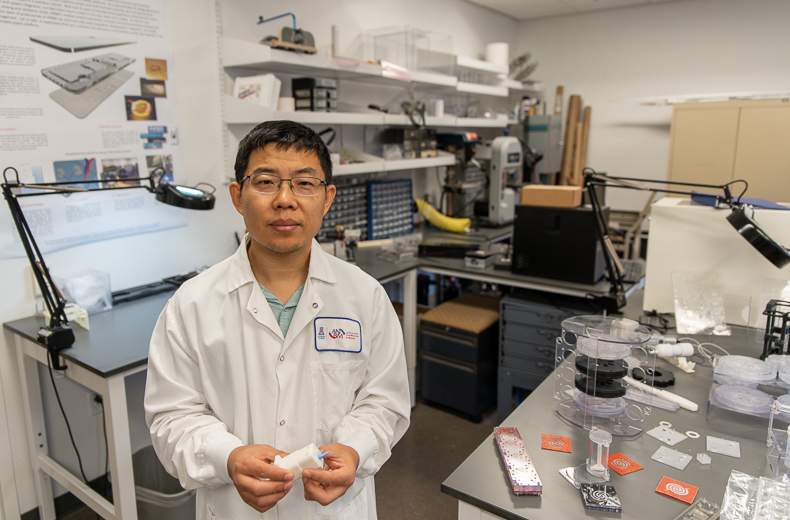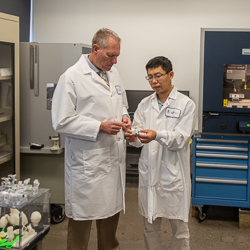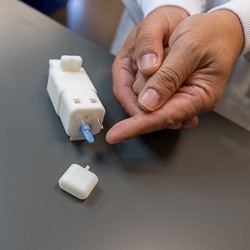
Blood-Collection Device Makes Radiation Testing Quick and Easy

A University of Arizona College of Medicine – Phoenix research team has developed a blood self-collection device to quickly estimate a person’s exposure to radiation in the event of a nuclear accident or attack.

The study, “Development of an integrated fingerstick blood self-collection device for radiation countermeasures,” was published Oct. 16 in PLOS One, a peer-reviewed, open-access journal that features research, commentary and analysis across all areas of science and medicine.
An easy-to-use, self-administered blood test that quickly could evaluate a person’s radiation exposure would help triage emergency medical treatment in the event of a radiological or nuclear event. The U.S. Department of Health and Human Services long has sought ways to monitor a population’s radiation exposure following such an event.
“Our research addressed a critical need of sample collection and pre-processing in biodosimetry logistics after a large-scale radiological event for radiation countermeasures,” Dr. Gu said.
Biological dosimetry determines the extent of damage to DNA caused by ionizing radiation associated with an acute exposure of a dirty bomb or nuclear accident. In ionizing radiation, electrons are knocked out of atoms and form charged particles.
In a nuclear event, hundreds of thousands of people would need to be screened in a very short time, and traditional medical infrastructure for blood collection may not be available.
The specimens need to be prepared for biodosimetry assays after collection. These assays measure the physical changes in a person’s tissues from radiation.
Dr. Gu’s work concentrated on the process of collecting and preparing blood to test exposure levels by providing a device that allows a person to collect their own sample that automatically could mix with assay reagents to hasten the process.
Using 3-D printing, a miniaturized vacuum tube, coupled with integrated capillaries and a lancet were fabricated into a self-collection device that can process the blood specimen for both cytogenetic and gene expression biodosimetry that then would be analyzed in a centralized bioanalytical laboratory. Cytogenetic biodosimetry measures the response of circulating blood lymphocytes in the body to accurately estimate the absorbed radiation dose. Gene expression biodosimetry measures the expression levels of a panel of radiation-sensitive genes for the absorbed dose. Results could be returned in one day in the gene expression tests and three days with the cytogenic tests.

“The integrated collector will alleviate the sample collection bottleneck for radiation countermeasures following a large-scale nuclear event, and may be useful in other applications with its self-collection and liquid reagent sample preprocessing capabilities,” Dr. Gu said.
The study is part of a core National Institutes of Health program, led since 2005 by Frederic Zenhausern, PhD, MBA, ANBM center director, in partnership with Columbia University and Georgetown University, under a U19 National Institute of Allergy and Infectious Diseases grant, sponsored by the Center for Medical Countermeasures Against Radiation. Teams at the UA College of Medicine – Phoenix and Columbia University have co-developed three major assay platforms for high-throughput biodosimetry, including gene expression, cytogenetics (a branch of genetics concerned with how chromosomes relate to cell behavior during mitosis and meiosis) and metabolomics (the study of small molecules, or metabolites within cells, blood or tissues).
In 2009, Dr. Zenhausern and his team also secured two simultaneous large development contracts from the Biomedical Advanced Research and Development Authority (BARDA) — one issued to Arizona State University and a second to Duke University and the UA. These initiatives produced several patents, publications and a startup company, DxTerity Diagnostics, which then was awarded as much as a $150 million BARDA procurement contract for advanced development and delivery of its REDI-Dx® test, now the first CE-IVD assay for radiation biodosimetry (2018).
Research funding was supported by grants: NIH/NIAID U19 grant with project number 5U19AI067773
About the College
Founded in 2007, the University of Arizona College of Medicine – Phoenix inspires and trains exemplary physicians, scientists and leaders to advance its core missions in education, research, clinical care and service to communities across Arizona. The college’s strength lies in our collaborations and partnerships with clinical affiliates, community organizations and industry sponsors. With our primary affiliate, Banner Health, we are recognized as the premier academic medical center in Phoenix. As an anchor institution of the Phoenix Bioscience Core, the college is home to signature research programs in neurosciences, cardiopulmonary diseases, immunology, informatics and metabolism. These focus areas uniquely position us to drive biomedical research and bolster economic development in the region.
As an urban institution with strong roots in rural and tribal health, the college has graduated more than 1,000 physicians and matriculates 130 students each year. Greater than 60% of matriculating students are from Arizona and many continue training at our GME sponsored residency programs, ultimately pursuing local academic and community-based opportunities. While our traditional four-year program continues to thrive, we will launch our recently approved accelerated three-year medical student curriculum with exclusive focus on primary care. This program is designed to further enhance workforce retention needs across Arizona.
The college has embarked on our strategic plan for 2025 to 2030. Learn more.